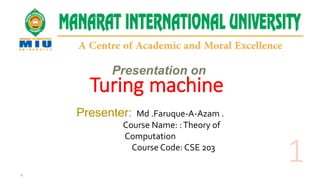Turing machine
•Download as PPTX, PDF•
0 likes•81 views
what is Turing Machine
Report
Share
Report
Share

Recommended
Recommended
More Related Content
What's hot
What's hot (20)
Finite Automata: Deterministic And Non-deterministic Finite Automaton (DFA)

Finite Automata: Deterministic And Non-deterministic Finite Automaton (DFA)
Analisa Expression pada after effect menggungakan bahasa script

Analisa Expression pada after effect menggungakan bahasa script
Similar to Turing machine
Similar to Turing machine (20)
Simulating Turing Machines Using Colored Petri Nets with Priority Transitions

Simulating Turing Machines Using Colored Petri Nets with Priority Transitions
Recently uploaded
Recently uploaded (20)
Query optimization and processing for advanced database systems

Query optimization and processing for advanced database systems
HAND TOOLS USED AT ELECTRONICS WORK PRESENTED BY KOUSTAV SARKAR

HAND TOOLS USED AT ELECTRONICS WORK PRESENTED BY KOUSTAV SARKAR
8th International Conference on Soft Computing, Mathematics and Control (SMC ...

8th International Conference on Soft Computing, Mathematics and Control (SMC ...
1_Introduction + EAM Vocabulary + how to navigate in EAM.pdf

1_Introduction + EAM Vocabulary + how to navigate in EAM.pdf
Convergence of Robotics and Gen AI offers excellent opportunities for Entrepr...

Convergence of Robotics and Gen AI offers excellent opportunities for Entrepr...
HOA1&2 - Module 3 - PREHISTORCI ARCHITECTURE OF KERALA.pptx

HOA1&2 - Module 3 - PREHISTORCI ARCHITECTURE OF KERALA.pptx
Unit 4_Part 1 CSE2001 Exception Handling and Function Template and Class Temp...

Unit 4_Part 1 CSE2001 Exception Handling and Function Template and Class Temp...
"Lesotho Leaps Forward: A Chronicle of Transformative Developments"

"Lesotho Leaps Forward: A Chronicle of Transformative Developments"
XXXXXXXXXXXXXXXXXXXXXXXXXXXXXXXXXXXXXXXXXXXXXXXXXXXX

XXXXXXXXXXXXXXXXXXXXXXXXXXXXXXXXXXXXXXXXXXXXXXXXXXXX
Turing machine
- 1. Presentation on Presenter: Md .Faruque-A-Azam . Course Name: :Theory of Computation Course Code: CSE 203 Turing machine
- 2. INTRODUCING TURING MACHINES Introduced by Alan Turing in 1936. A simple mathematical model of a computer. Models the computing capability of a computer.
- 3. DEFINITION OF TURING MACHINE A Turing machine is a mathematical model of computation that defines an abstract machine, which manipulates symbols on a strip of tape according to a table of rules. Despite the model's simplicity, given any computer algorithm, a Turing machine capable of simulating that algorithm's logic can be constructed. It normally accepts the input string, or completes its computation, by entering a final or accepting state.
- 4. REPRESENTATION OF TURING MACHINE A Turing Machine is expressed as a 7-tuple (Q, T, B, ∑, δ, q0, F) where: •Q is a finite set of states •T is the tape alphabet (symbols which can be written on Tape) •B is blank symbol (every cell is filled with B except input alphabet initially) •∑ is the input alphabet (symbols which are part of input alphabet) •δ is a transition function which maps Q × T → Q × T × {L,R}. Depending on its present state and present tape alphabet (pointed by head pointer), it will move to new state, change the tape symbol (may or may not) and move head pointer to either left or right. •q0 is the initial state •F is the set of final states. If any state of F is reached, input string is accepted.
- 5. X1 X2 … Xi … Xn B B … Finite Control R/W Head B Tape divided into cells and of infinite length Input & Output Tape Symbols THE TURING MACHINE MODEL
- 6. PROPERTIES OF TURING MACHINES A Turing machine can recognize a language iff it can be generated by a phrase-structure grammar. The Church-Turing Thesis: A function can be computed by an algorithm iff it can be computed by a Turing machine.
- 7. THANKS 7
